What Are The Different Types Of Fabrics For Awning?
2024-11-13
Awnings are a popular addition for both residential and commercial spaces, providing shade, style, and protection from the elements. Choosing the right fabric is essential for durability, aesthetics, and functionality. Here are some of the most common types of fabrics used for awnings, along with their unique qualities:
1. Acrylic Fabric
- Properties: Acrylic fabrics are popular for their durability, water resistance, and fade resistance. They are often dyed with solution-dyed acrylic, which locks in color, making them highly resistant to UV rays and color fading.
- Applications: Acrylic is ideal for residential awnings, such as patio or deck coverings, due to its soft, fabric-like feel and longevity in outdoor environments.
- Advantages: UV-resistant, mold-resistant, fade-resistant, and offers excellent breathability to prevent heat buildup under the awning.

2. Polyester Fabric
- Properties: Polyester fabrics can be coated to enhance weather resistance, UV protection, and color retention. When uncoated, polyester is lightweight and more affordable, although not as durable as acrylic in extended sun exposure.
- Applications: Commonly used in retractable awnings, pop-up canopies, and budget-friendly awnings for shorter-term use.
- Advantages: Lightweight, affordable, and comes in various colors and designs. With coatings, polyester can become water- and UV-resistant, making it more durable.
3. Vinyl-Coated Polyester
- Properties: This fabric combines the lightweight flexibility of polyester with a vinyl coating, providing enhanced durability, water resistance, and mildew resistance. It’s often used in high-humidity or marine environments due to its resilience.
- Applications: Ideal for commercial awnings, storefronts, and environments with high humidity or potential exposure to saltwater.
- Advantages: Very strong, waterproof, resistant to mildew and UV rays, and easy to clean. It is slightly heavier and stiffer than acrylic or plain polyester but offers excellent protection.
4. Canvas Fabric
- Properties: Canvas is one of the traditional materials used for awnings. Made from cotton or a cotton blend, it has a soft, natural look but requires a waterproof coating to prevent absorption of rainwater. While it can be durable, canvas may need more maintenance and is more susceptible to mildew.
- Applications: Popular in rustic or classic designs for residential and commercial use, especially where a natural look is desired.
- Advantages: Breathable and has a classic look. When treated with coatings, it can be made resistant to water and UV rays, but it generally requires more care and maintenance.
5. Solution-Dyed Acrylic
- Properties: This is a premium version of acrylic fabric, in which the dye is infused during the fiber creation process. This makes it highly resistant to fading, as the color permeates the entire fiber.
- Applications: Frequently used in high-quality residential awnings, outdoor umbrellas, and commercial awnings where appearance and durability are both important.
- Advantages: Superior color retention, water resistance, UV protection, and resistance to mold and mildew. It offers long-lasting vibrancy and protection against the elements.
6. Mesh Fabric
- Properties: Mesh fabrics are woven to allow air and some light to pass through, providing shade while allowing ventilation. They block a percentage of UV rays but not all, making them more suitable for partial shade rather than complete coverage.
- Applications: Often used in poolside, patio, and outdoor restaurant awnings, where air circulation is beneficial and complete sun blockage is not required.
- Advantages: Offers cooling benefits due to air permeability, is UV resistant, and available in various openness factors to control the amount of sunlight and privacy desired.
7. Polyethylene (PE) Fabric
- Properties: Polyethylene is a durable synthetic material often used for shade sails and temporary outdoor awnings. It is resistant to UV rays, tearing, and mildew but can degrade if exposed to prolonged direct sunlight without UV protection.
- Applications: Primarily used in temporary awnings, shade structures, or event tents.
- Advantages: Lightweight, affordable, tear-resistant, and provides excellent UV protection. It is also recyclable, making it an eco-friendly option for short-term use.
8. PVC-Coated Fabric
- Properties: Made from polyester fabric coated with polyvinyl chloride (PVC), this material is waterproof, durable, and resistant to mildew, chemicals, and UV rays. It is heavy-duty and often used for permanent or semi-permanent awnings.
- Applications: Commonly used in commercial awnings, carports, and industrial applications where maximum durability and weather resistance are essential.
- Advantages: Extremely durable, waterproof, easy to clean, and offers excellent UV and chemical resistance. However, it is heavier and less flexible than acrylic or mesh.
9. Silicone-Coated Fabric
- Properties: Silicone coating on polyester or other synthetic fabrics enhances water repellency and UV resistance, while also providing flexibility and durability. It’s used for both residential and commercial awnings, offering protection and ease of maintenance.
- Applications: Often used in retractable awnings, high-end residential covers, and some commercial structures.
- Advantages: Lightweight, flexible, and highly resistant to water and UV rays. Silicone coatings also resist dirt accumulation and are easy to clean.
Summary
Selecting the right fabric for an awning depends on factors like durability, UV resistance, waterproofing, and the aesthetic appeal you desire. For long-term and heavy-duty use, materials like vinyl-coated polyester or PVC-coated fabrics provide excellent protection. For more casual or temporary shade, mesh and polyethylene fabrics offer cost-effective options.




















































